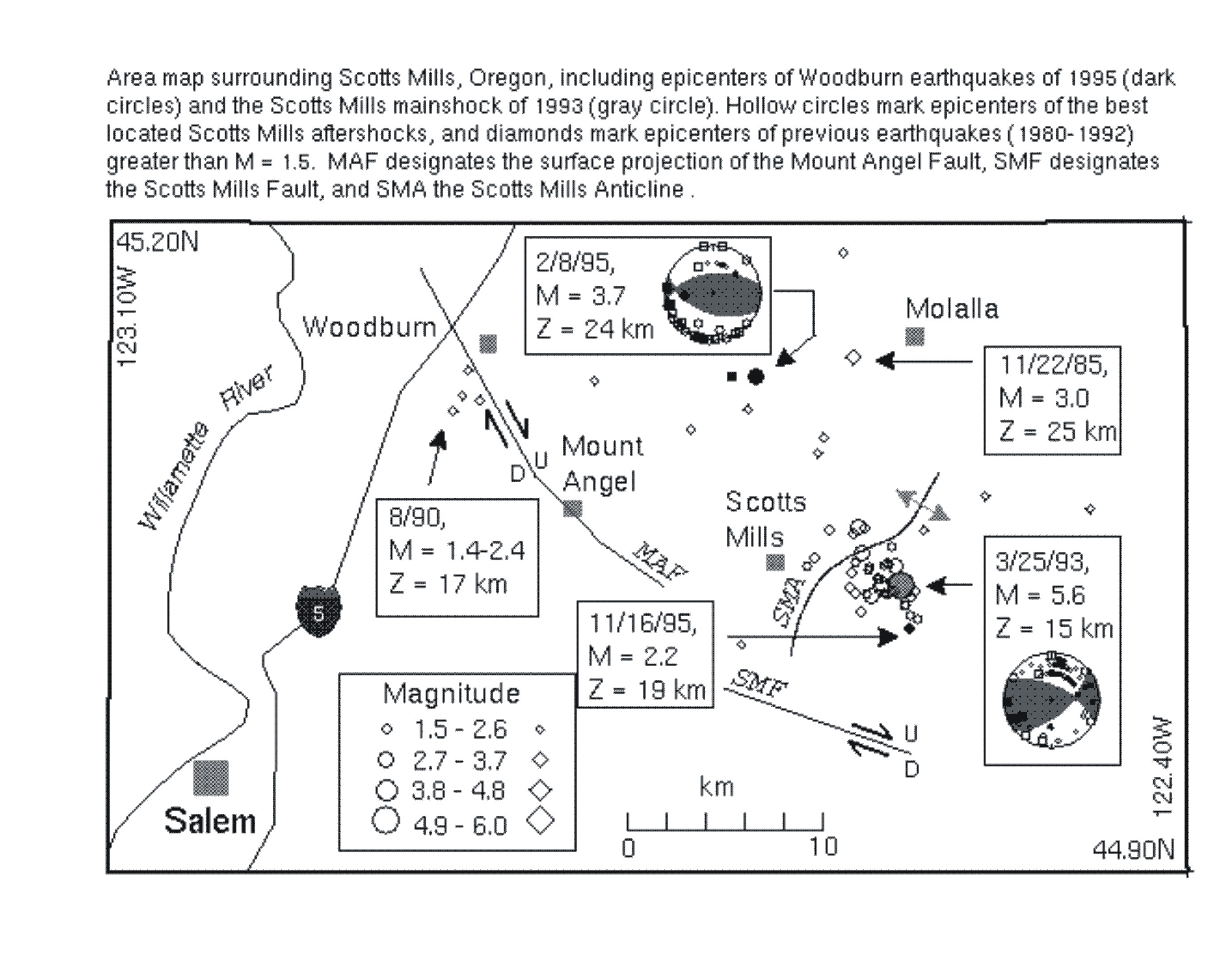
The Scotts Mills earthquake, which occurred in Oregon on March 25, 1993 at 13:34 UT, with ML = 5.6, was the largest earthquake in the Pacific Northwest since the Elk Lake and Goat Rocks earthquakes of 1981. The Scotts Mills mainshock epicenter was located at at 45.03 N, 122.59 W, about 5 km east of the town of Scotts Mills, and about 54 km south of Portland. Ground motion was widely felt in the Willamette Valley and even the Puget Sound Basin, with felt reports from Roseburg, Oregon, to as far north as Seattle, Washington. Dewey et. al. (1994) report that strong motion instruments recorded peak ground accelerations of 0.06 g at Detroit Dam, 44 km to the southeast, and also give an extensive review of damage reports and ground motion intensities. Most structural damage consisted of toppled chimneys and failure of walls of unreinforced masonry (Dewey et. al., 1994). Buildings with damage include Molalla High School and the State Capitol in Salem. The lack of injuries can probably be attributed to the fact that the earthquake occurred in the early morning.
Of the nearly 200 aftershocks detected, there is sufficient data to reliably locate epicenters for 149 aftershocks (by combining data from permanent PNSN and temporary USGS stations). Figure 1 shows the locations of the mainshock, 149 aftershocks of coda magnitude 1.0 or greater, and locations of nearby towns. Seismic activity for the aftershock sequence was highest in the first week following the mainshock. Epicenters have been found for 71 aftershocks occurring in the first week following the mainshock, for 62 aftershocks in the remainder of 1993, and for 16 aftershocks occurring in 1994. There were 72 aftershocks of coda magnitude 2.0 or greater and 8 aftershocks of coda magnitude 3.0 or greater. Eleven of the aftershocks were felt. The largest aftershock, with Mc = 3.9, occurred three months after the mainshock, on June 8, 1993. The data collected by the PNSN was augmented by portable seismometer data collected by the US Geological Survey between March 26, 1993, and April 15, 1993 (Carver and Whorley, 1993). The PNSN catalog, with 115 earthquakes, appears complete down to events of coda magnitude about 1.8 (Thomas and Crosson).
The mainshock epicenter is located about 10 km east of the terminus of the Mount Angel Fault Zone (MAFZ), as shown in Figure 1. The MAFZ has been interpreted as a subsurface reverse fault, dipping to the northeast, with both right-lateral strike-slip motion and reverse motion (Werner et. al.). The Scotts Mills earthquake and afte rshock sequence appear consistent with an extension of the MAFZ (Thomas et. al., 1993; Thomas and Crosson (in preparation). The PNSN and USGS data have been combined to obtain a subset of 52 aftershocks with well constrained depths. These form a steeply dipping plane, with a geometry consistent with the MAFZ. Figure 1 shows the surface projection of the fault plane associated with the Scotts Mills sequence, designated SMZ, and also shows the location of the MAFZ. The inset in Figure 1 shows a cross section through the subset of aftershocks with the best constrained depths.

References
Carver, David, and David Whorley Digital recordings of aftershocks of the March 25, 1993, Scotts Mills, Oregon, earthquake, US Geological Survey Open-File Report 93-535, 1993.
Dewey, JW, BG Reagor, D Johnson, GL Choy, and F Baldwin, The Scotts Mills, Oregon, earthquake of March 25, 1993: Intensities, strong motion data, and teleseismic data, US Geological Survey Open-File Report 94-163, 1994.
Thomas, GC, RS Crosson, S Dewberry, J Pullen, T Yelin, R Norris, WT Bice, D Carver, M Meremonte, D Overturf, and D Whorley, The 25 March 1993 Scotts Mills, Oregon, earthquake: Aftershock analysis from combined permanent and temporary digital stations (abstract), EOS Trans, 74, 201, 1993.
Thomas, GC, and RS Crosson, The 25 March 1993 Scotts Mills, Oregon, earthquake and aftershock sequence: Spatial distribution, focal mechanisms, and the Mount Angel Fault, Bulletin of the Seismological Society of America, 86, 925-935, 1996.
Werner, K, J Nabelek, R Yeats, and S Malone, The Mt. Angel Fault: Implications of seismic reflection data and the August, 1990, Woodburn, Oregon, earthquake sequence, Oregon Geology, 54, 112-117, 1992.
Back to:...
UW Dept. of Earth and Space Sciences ..... PNW EARTHQUAKES
University of Washington Dept. of Earth and Space Sciences, Box 351310 Seattle, WA, 98195-1310